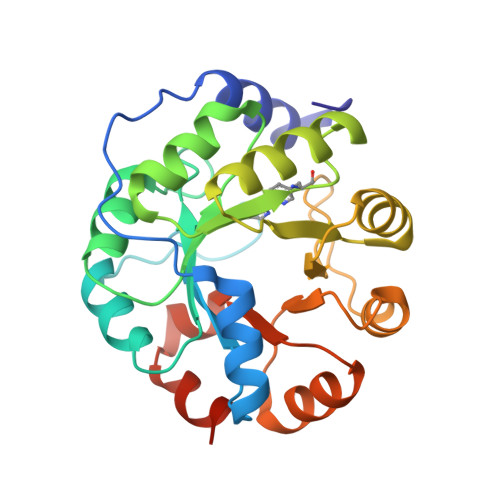Computational design of an unnatural amino Acid dependent metalloprotein with atomic level accuracy.
Mills, J.H., Khare, S.D., Bolduc, J.M., Forouhar, F., Mulligan, V.K., Lew, S., Seetharaman, J., Tong, L., Stoddard, B.L., Baker, D.(2013) J Am Chem Soc 135: 13393-13399
- PubMed: 23924187
- DOI: https://doi.org/10.1021/ja403503m
- Primary Citation of Related Structures:
4IWW, 4IX0, 4J9T - PubMed Abstract:
Genetically encoded unnatural amino acids could facilitate the design of proteins and enzymes of novel function, but correctly specifying sites of incorporation and the identities and orientations of surrounding residues represents a formidable challenge. Computational design methods have been used to identify optimal locations for functional sites in proteins and design the surrounding residues but have not incorporated unnatural amino acids in this process. We extended the Rosetta design methodology to design metalloproteins in which the amino acid (2,2'-bipyridin-5yl)alanine (Bpy-Ala) is a primary ligand of a bound metal ion. Following initial results that indicated the importance of buttressing the Bpy-Ala amino acid, we designed a buried metal binding site with octahedral coordination geometry consisting of Bpy-Ala, two protein-based metal ligands, and two metal-bound water molecules. Experimental characterization revealed a Bpy-Ala-mediated metalloprotein with the ability to bind divalent cations including Co(2+), Zn(2+), Fe(2+), and Ni(2+), with a Kd for Zn(2+) of ∼40 pM. X-ray crystal structures of the designed protein bound to Co(2+) and Ni(2+) have RMSDs to the design model of 0.9 and 1.0 Å respectively over all atoms in the binding site.
Organizational Affiliation:
Department of Biochemistry and ⊥Biomolecular Structure and Design Program, University of Washington , Seattle, Washington, United States.

















